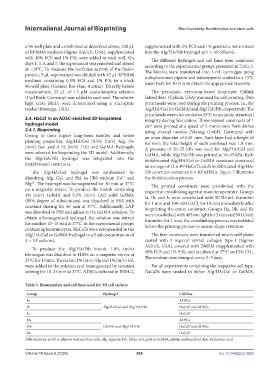Page 273 - IJB-10-6
P. 273
International Journal of Bioprinting Skin bioprinting: Keratinocytes and stem cells
a 96-well plate and crosslinked as described above; 100 µL supplemented with 2% FCS and 1% geneticin, were mixed
of RPMI40 medium (Sigma Aldrich, USA), supplemented into the Alg/HA/Fib hydrogel at 1 × 10 cells/mL.
6
with 10% FCS and 1% P/S, were added to each well. On The different hydrogels and cell lines were combined
days 1, 3, 5, and 7, the supernatant was removed and stored according to the experimental groups presented in Table 3.
at −20°C. To measure the luciferase activity of the fusion The bioinks were transferred into 3-mL cartridges using
protein, 5 µL supernatant was diluted with 45 µL RPMI40 a displacement pipette and subsequently cooled in a 15°C
medium, containing 0.5% FCS and 1% P/S, in a black water bath for 10 min to obtain the appropriate viscosity.
96-well plate (Greiner Bio-One, Austria). Directly before
measurement, 25 µL of 1.5 µM coelenterazine solution The pneumatic extrusion-based bioprinter Cellink
(Carl Roth, Germany) was added to each well. The relative Inkredible+ (Cellink, USA) was used for cell-printing. Two
light units (RLU) were determined using a microplate print heads were used during the printing process, i.e., for
reader (Promega, USA). Alg/HA/Gel (or GelMA) and Alg/HA/Fib, respectively. The
print heads were also cooled to 15°C to maintain structural
2.4. HaCaT in an ADSC-enriched 3D-bioprinted integrity during fabrication. Three-layered constructs of 1
hydrogel model cm were printed at a speed of 5 mm/s onto Petri dishes
2
2.4.1. Bioprinting using conical nozzles (Vieweg GmbH, Germany) with
Owing to their higher long-term stability and better an inner diameter of 0.41 mm. Each layer had a height of
printing properties, Alg/HA/Gel (0.5% [m/v] Alg; 3% 0.6 mm; the total height of each construct was 1.8 mm.
[m/v] Gel; and 0.1% [m/v] HA) and GelMA hydrogels A pressure of 20–25 kPa was used for Alg/HA/Gel and
were selected for bioprinting the 3D model. Additionally, GelMA, while Alg/HA/Fib was printed at 10–15 kPa. Each
the Alg/HA/Fib hydrogel was integrated into the biofabricated Alg/HA/Gel or GelMA construct contained
biofabricated constructs. an average of 12 × 10 HaCaTs; each biofabricated Alg/HA/
4
The Alg/HA/Gel hydrogel was synthesized by Fib construct contained 6 × 10 ADSCs. Figure 3 illustrates
4
dissolving Alg, Gel, and HA in PBS without Ca and the biofabrication process.
2+
2+
Mg . The hydrogel was homogenized for 30 min at 37°C The printed constructs were crosslinked with the
on a magnetic stirrer. To produce the bioink containing respective crosslinking agent at room temperature. Groups
4% (m/v) GelMA and 0.2% (m/v) LAP, solid GelMA Ia, Ib, and Ic were crosslinked with 50 IU/mL thrombin
(80% degree of substitution) was dissolved in PBS with for 1 min and 100 mM CaCl for 10 min immediately after
constant stirring for 30 min at 37°C. Additionally, LAP bioprinting the entire construct. Groups IIa, IIb, and IIc
2
was dissolved in PBS and added to the GelMA solution. To were crosslinked with 405 nm light for 2 min and 50 IU/mL
obtain a homogenized hydrogel, the solution was stirred thrombin for 1 min; the crosslinking process was initiated
for another 10–15 min at 37°C. In the experimental groups before the printing process to ensure shape retention.
containing keratinocytes, HaCaTs were resuspended in the
Alg/HA/Gel or GelMA hydrogel to a final concentration of The firm constructs were transferred into 6-well plates
6
1 × 10 cells/mL. coated with 3 mg/cm rat-tail collagen type I (Sigma-
2
Aldrich, USA), covered with DMEM (supplemented with
To produce the Alg/HA/Fib bioink, 1.8% (m/v)
fibrinogen was dissolved in HBSS on a magnetic stirrer at 10% FCS and 1% P/S), and incubated at 37°C and 5% CO .
2
25°C for 15 min. Thereafter, 1% (m/v) Alg and 1% (m/v) HA The medium was changed every 2–3 days.
were added to the solution and homogenized by constant For all experiments containing the respective cell type,
stirring for 10–15 min at 37°C. ADSCs cultured in EBM-2, HaCaTs were seeded in either Alg/HA/Gel or GelMA,
Table 3. Biomaterials and cell lines used for 3D cell culture
Group Hydrogel Cell line
Ia ADSCs
Ib Alg/HA/Gel and Alg/HA/Fib HaCaT and ADSCs
Ic HaCaT
IIa ADSCs
IIb GelMA and Alg/HA/Fib HaCaT and ADSCs
IIc HaCaT
Abbreviations: ADSCs, adipose-derived stem cells; Alg, alginate; Fib, fibrin; Gel, gelatin; GelMA, gelatin methacryloyl; HA, hyaluronic acid.
Volume 10 Issue 6 (2024) 265 doi: 10.36922/ijb.3925

